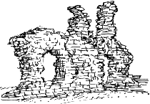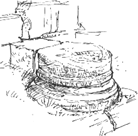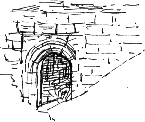
'The Devil's Stone'Wednesday 22nd March 2000 BUTTERBUR is in flower amongst the ferny leaves of Cow Parsley on the banks of Pugneys Drain. Huge leaves, the size of rhubarb leaves, appear after the flowers have gone to seed.
BUTTERBUR is in flower amongst the ferny leaves of Cow Parsley on the banks of Pugneys Drain. Huge leaves, the size of rhubarb leaves, appear after the flowers have gone to seed.My first Small Tortoiseshell flies along by the side of a ploughed field.
Five young schoolboys come to see what I'm drawing, then they scramble down into the moat and up again to the top of the motte on what is obviously a regular route home. Later, four older boys appear and start a rowdy game of football on the bailey that involves repeated trips down into the depths of the moat to retrieve the lost ball and quite a kick to get it back up to the bailey again. I hate to think what effect all this has on archaeological evidence that will be lost for ever, but it is a timeless scene. Children must have been playing here almost daily since the castle was demolished after the seige during the Cromwellian Civil War. Going back further there were probably rowdy games of football here when medieval soldiers had the odd moment of relaxation.
The boys in our class went climbing on the ruins and eventually I joined in. I climbed the tallest chunk of ruin, taking the route I'd seen the others follow. When I got up there I realised I'd been so involved in climbing that I hadn't noticed that everyone had suddenly vanished and my party was heading home. I was alone, miles from home, up on a crumbling ruin, at the highest point in the landscape for miles around.
'Are you all right? Sit down. You've been on the “the Devil's Stone”! haven't you? You can climb on all the other stones, but there's just that one big stone and, when you climb on it, it starts to rock. I've only been on “the Devil's Stone” once and I was as scared as you. I wouldn't ever go on it again. Hey, Terry, this kid's been on “the Devil's Stone” . . .' I hurried down from the bailey and caught up with the group as they left the castle grounds.
|
 It's like a still summer's day, so I take the chance to sketch at Sandal Castle, on what is usaully the most windswept of places. It stands on a ridge of Oaks Rock sandstone with a panoramic view over a meander of the Calder Valley. Before the housing estate of Portobello filled part of the battlefield site below, there must have been a clear view to the Chantry Bridge across the Calder.
It's like a still summer's day, so I take the chance to sketch at Sandal Castle, on what is usaully the most windswept of places. It stands on a ridge of Oaks Rock sandstone with a panoramic view over a meander of the Calder Valley. Before the housing estate of Portobello filled part of the battlefield site below, there must have been a clear view to the Chantry Bridge across the Calder. A Skylark sings high above the fields, but I'm up here on a level with it, as I sit sketch from the earthen ramparts.
A Skylark sings high above the fields, but I'm up here on a level with it, as I sit sketch from the earthen ramparts. I remember a school trip to the castle, when I was aged about nine. We'd walked alongside the Calder from Horbury for three miles in the hot summer sun. This was some years before the site was excavated, so trees and vegetation still covered the earthworks and the moats were almost filled with debris. The motte looked like a natural feature. You wouldn't have guessed then how complete a picture of the castle would be built up in summer digs during the next decade or so. The evidence still lay hidden.
I remember a school trip to the castle, when I was aged about nine. We'd walked alongside the Calder from Horbury for three miles in the hot summer sun. This was some years before the site was excavated, so trees and vegetation still covered the earthworks and the moats were almost filled with debris. The motte looked like a natural feature. You wouldn't have guessed then how complete a picture of the castle would be built up in summer digs during the next decade or so. The evidence still lay hidden. I climbed down as quickly as I could. A few local boys were passing by, and, seeing how panic-struck I was, one of them asked;
I climbed down as quickly as I could. A few local boys were passing by, and, seeing how panic-struck I was, one of them asked;